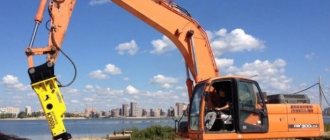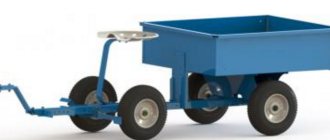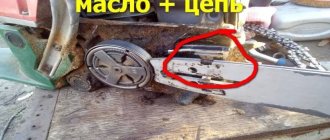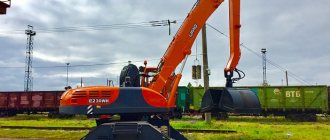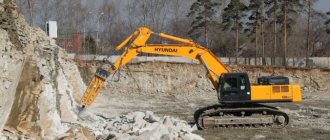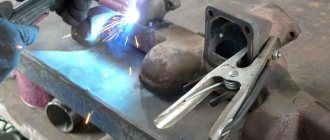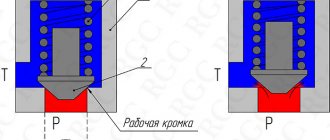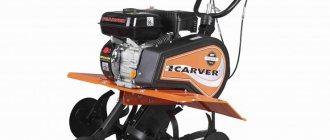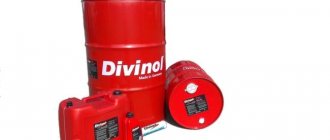First way
The machine has a certain lifting capacity and hydraulic system capabilities. These two parameters, as a rule, are quite sufficient to determine a small number of suitable hydraulic hammers from the entire wide range.
The technical description of the hydraulic hammer indicates the nominal hydraulic performance values of the base machine and the maximum permissible parameters, such as peak hydraulic pressure values.
For example: Hammer HB 330 hydraulic hammer is recommended for use in the working fluid flow range from 160 to 250 liters per minute. The operating pressure should be in the range of 150 to 160 bar, and the maximum permissible pressure should not exceed 160 bar. All manufacturers of hydraulic hammers provide such data, and you can easily find them in the description of hydraulic hammers.
By comparing them with the readings of the base machine, at the first stage we cut off weaker models of hydraulic hammers. Next, we remove the heavier hydraulic hammers, since their requirements for the flow and pressure of hydraulic fluid will be higher than our excavator can produce. We will have several models that fit the parameters.
Now let's select models in the hydraulic range above average, i.e. the capabilities of our machine must be from 80 to 100 percent of the readings required by the hydraulic hammer. And we will have even fewer models that fit our excavator. Usually these are two or three models of hydraulic hammers.
It would not be superfluous to check the lifting capacity of the excavator at full reach of the boom, comparing it with the weight of the hydraulic hammer. If the value is on the verge of the machine’s capabilities, then it will be safer not to use such a hydraulic hammer, as they say, “what if something happens.” The operator will hook the reinforced concrete slab and lift it with a hammer, and the risk of tipping over will be enormous. Let's not take risks.
At the end we will have a couple of models left. The difference between them will be in the frequency of impacts and power output.
Sometimes the “impact energy” parameter is considered, but this is a far-fetched figure and believing it unconditionally is not the path of a wise buyer.
The impact energy of a hydraulic hammer is a calculated value; it can only be measured in fact using a specialized stand, which the vast majority of manufacturers of hydraulic hammers do not possess.
Since you cannot check this value, you can write whatever you want in the characteristics. Well, there have always been plenty of science fiction writers and storytellers among the sellers.
Now let's turn to materials and work.
Accordingly, if the material (soil) is soft or cracked, then we select a higher frequency and a lighter model. This will provide better performance.
If the material is hard, especially monolithic, then you should definitely choose a heavier hydraulic hammer. But if you choose a hydraulic hammer for all occasions, then take the average one in terms of performance. This will somewhat affect your productivity, but will make the “excavator + hydraulic hammer” combination more versatile. Especially if you provide excavator rental services or often use the machine at different sites.
Device
Considering the diagram of the MG-300 hydraulic hammer, several parts can be distinguished: the striker, the working tool, the hydraulic distributor, the nitrogen chamber, and the housing. The striker moves inside the body and transfers energy to the working tool.
The nitrogen chamber is necessary to dampen the backlash of the striker in order to reduce the negative impact on both the hydraulic hammer itself and the excavator.
The MG-300 hydraulic hammer has a number of features, such as:
- The intake and exhaust of air occurs outside the working area, which protects the working valve from dust and has a positive effect on durability;
- Modern coatings are used, as well as seals, which made it possible to get rid of quickly worn-out bronze liners. This extends the warranty period;
- A new axlebox design is used, which allows you to replace the working tool much faster, and there is no need to replace “crackers” that quickly wear out;
- Operation of the hydraulic hammer is allowed at sub-zero temperatures down to -40.
It can be equipped with such interchangeable tools as a wedge, a lance, and a rammer. Upon request, the hydraulic hammer can be manufactured with any profile. It can also be equipped with an additional valve, which will allow the tool’s pneumatic system to operate automatically, and not from the excavator’s compressor.
Second way
The second selection path is based on the type of material being destroyed. The age-old question of what comes first, the egg or the chicken, is even more ambiguous in this matter.
We are forced to choose a hydraulic hammer for the rock and a base machine for the hammer.
There are often cases when a hydraulic hammer is used for an object with thousands of cubic meters of excavation. In this case, the analogy as stated above is applicable: hard material means a heavier model, soft means a lighter model of a hydraulic hammer, but with a high frequency.
As mentioned earlier, high frequency is important for highly fractured rocks. This is especially true when working with weathered rocks. But this will not be the final cut-off of models.
It is important to evaluate performance using the appropriate charts, but not all manufacturers provide them.
From, upon request, you will receive such data for each line of hydraulic hammers.
Looking for a hydraulic hammer? We will help you choose an effective and affordable solution.
Choose a hydraulic hammer
Based on this data, you choose exactly the model that produces shift averages that meet your requirements.
For example, and this is a real case, it is necessary to produce 4,000 cubic meters per twenty-hour shift. One hydraulic hammer will not do the job; you need at least a couple of them.
If these are membrane models, such as Hammer, then two, if piston, then three units. Your budget will help you determine what type of hammer you can handle.
But do not forget that the more hydraulic hammers, the more excavators need to be used (and this means an additional operator, fuel, maintenance costs and much more), so you should not limit yourself to simply comparing budgets for the purchase of hydraulic hammers. It is necessary to take into account all costs as a whole, determining the actual cost per cubic meter.
By comparing the material to be destroyed by performance chart and type of destruction (concrete destruction, oversized or mining), you can easily select the optimal model. And then select an excavator for it.
Choosing a hydraulic hammer manufacturer
There are at least 60 manufacturers of hydraulic hammers in the world who sell their products. In addition, you can find the same number of unknown manufacturers with a small production volume (about 50 units per year). Despite such diversity, Korean-made hydraulic hammers have gained the greatest popularity in Russia, as the most reliable equipment at an adequate price.
Experts warn: if you receive an offer for a hydraulic hammer at a low price, but cannot find information about this manufacturer anywhere, then you need to understand that low quality is behind this.
The cost of a hydraulic hammer is formed from the following components:
- labor costs;
- cost of metal and components;
- manufacturer's marginal profit.
Labor cost
It is obvious that small unknown factories cannot retain highly qualified specialists. As a rule, unskilled workers are employed in production to reduce production costs, so the risk of human errors during assembly and production is very high. Large enterprises are trying to reduce the cost of labor per unit of output by increasing the total volume and conveyor belt of production. All this creates another advantage - the elimination of risks associated with the human factor.
The bodies of Profbreaker light and medium hydraulic hammers of the RV50N, RV70N, RV150N, RV180N, RV180S series are welded without the use of labor at all using fully robotic welding machines.
Robotic welding of Profbreaker hydraulic hammers
2. Cost of metal and components
A reputable supplier will never use low-quality steel in the production of hydraulic hammer cylinders and pistons, as it values its reputation and its customers. Profbreaker hydraulic hammers are produced in factories that use only high-quality Korean steel from the Hanlip concern (South Korea). All metal undergoes input control in our own laboratories. Low cost is achieved due to large volumes of metal purchases in accordance with the annual production plan.
Unknown small enterprises cannot afford annual purchases of high-quality metal and incoming inspection.
They also cannot purchase modern high-quality machines.
Grinding of the most important structural elements - the piston and cylinder of the Profbreaker hydraulic hammer - is carried out on a unique vertical grinding machine, while most other manufacturers use horizontal grinding.
Vertical grinding has several main advantages:
- The machine can automatically adjust the processing size based on the drawing saved on the computer;
- accuracy reaches 0.0001. For horizontal grinding, accuracy is 0.001;
- Vertical grinding avoids misalignment during the grinding process, which always occurs in a horizontal grinding machine.
Vertical grinding of Profbreaker hydraulic hammers
Manufacturer's marginal profit
This is what we mean by brand fees. It's not always that what costs more is actually better. It happens that the brand name is widely known all over the world and this is the reason for the high cost. A well-known brand, by all accounts, always guarantees high quality, but this coin also has a downside. The more famous the manufacturer, the more so-called fakes and forgeries he has. A huge number of small manufacturers in China have built their business on stamping counterfeits and markings.
Life time
An extremely important indicator when choosing spare parts is the service life and reliability of the equipment. No one is interested in spending money on something that will break before it even has time to pay for itself. The need to constantly repair something will also not please a potential buyer. What do these indicators depend on? Mainly from materials, design features and production technologies used. If you are considering hammers with approximately the same characteristics, then take the one with as few parts, assemblies and protruding elements as possible. If you want to extend the life of this attachment, then pay attention to the “Auto-stop” function. Its essence is as follows: if there is no contact of the hydraulic hammer with the ground or the surface being processed, the operation of the device stops.
Applications of hydraulic hammers
A mini-excavator-based hydraulic hammer is a very convenient and useful piece of equipment that is used to perform many heavy jobs:
- when removing rocky, frozen or hard soil;
- dismantling asphalt or concrete road surfaces;
- removing slabs and curbs;
- destruction of emergency buildings, dismantling of foundations;
- crushing a monolithic or reinforced concrete structure;
- rock mining in quarries;
- compaction of soil for construction;
- deepening piles for the future foundation, etc.
Fluid flow
This value is indicated in the device data sheet. It must match the performance of the hydraulic pump that is responsible for the line of this attachment. The base loader may have more capacity than required. This can lead to pressure peaks during operation, which, in turn, have a negative impact on the service life of the device. If this indicator is less, then the device may not work at all or may not function entirely correctly.
Alexander Belyaev from Surgut, 42 years old, asks a question:
I want to buy myself special equipment to quickly chip away ice build-ups in winter. I would like to know what types of hydraulic hammers exist?
Our specialist answers:
The main parameter of hydraulic hammers is impact energy. Depending on it, devices are divided into several types:
- heavy (impact more than 3500 J);
- medium (impact from 1500 to 3500 J);
- small (impact from 400 to 1500 J).
Small class
Features of small class hydraulic hammers are:
- light weight;
- mobility;
- compact dimensions;
- ability to work in hard-to-reach places.
Composition of the lightweight hydraulic hammer BRUCE SGH series
With the help of these devices, work is carried out to destroy objects near which other structures are located. The smallest types can be used inside buildings for renovation or renovation.
Small hydraulic hammers are suitable for the following construction operations:
- opening asphalt;
- removal of ice build-up;
- drilling brickwork;
- soil compaction with additional equipment.
The disadvantage of such devices is their low performance.
Small type hydraulic hammers
